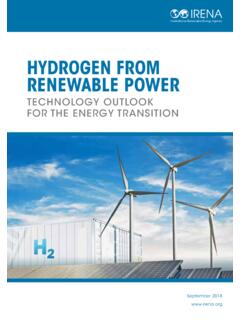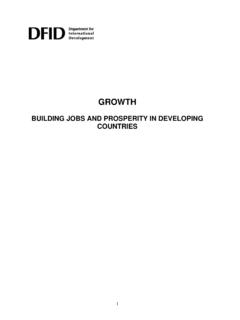Transcription of HYDROGEN STRATEGY - Energy
1 HYDROGEN STRATEGYE nabling A Low-Carbon EconomyOffice of Fossil EnergyUnited States Department of EnergyWashington, DC 20585 HYDROGEN STRATEGYE nabling A Low-Carbon EconomyOffice of Fossil EnergyUnited States Department of EnergyWashington, DC 20585[ i ] HYDROGEN STRATEGYE nabling A Low-Carbon EconomyContentsIntroduction ..1 Background ..2 HYDROGEN Production and Cost ..5 HYDROGEN Uses and Equivalent Costs ..7 HYDROGEN Demand ..8 Emerging Markets and International Initiatives ..10 HYDROGEN Transportation ..11 HYDROGEN Storage ..13 Office of Fossil Energy ..13 Office of Clean Coal and Carbon Management HYDROGEN R&D Program ..13 Office of Oil and Natural Gas HYDROGEN R&D Program ..14 Accelerating the HYDROGEN Economy with Future R&D ..15 Safety and Regulatory Requirements and Challenges ..17 References ..19[ 1 ] HYDROGEN STRATEGYE nabling A Low-Carbon EconomyIntroductionThis document summarizes current HYDROGEN technologies and communicates the Department of Energy (DOE), Office of Fossil Energy 's (FE s) strategic plan to accelerate research, development, and deployment of HYDROGEN technologies in the United States.
2 It also describes ongoing FE HYDROGEN -related research and development (R&D). HYDROGEN produced from fossil fuels is a versatile Energy carrier and can play an important role in a transition to a low-carbon (H2) is the simplest and most abundant element in the universe, and it only occurs naturally on Earth when combined with other elements. HYDROGEN , like electricity, is an Energy carrier (fuel) that can be used to store, move, and deliver Energy produced from other sources. It can be produced without a carbon footprint from a variety of sources, including natural gas, coal, biomass, waste materials ( , plastics), or splitting water molecules. Gasification of fossil fuels with biomass and plastics is expected to be the lowest-cost route to providing carbon negative HYDROGEN when using carbon capture, utilization, and storage (CCUS) have been interested in HYDROGEN as a source of Energy since the 1800s,1 and it is currently an essential feedstock and fuel in many industries.
3 Primary uses of HYDROGEN include the following applications: (1) as a chemical in ammonia (NH3) production (mainly for fertilizers), (2) as a chemical feedstock and catalyst, (3) as a hydrogenating agent for food and drug production, and (4) in petrochemical and refinery processing. HYDROGEN consumed by large volume users is typically generated onsite (captive HYDROGEN ), and for industries such as glass manufacture, food, and electronics, it is supplied by trailers (merchant HYDROGEN ).In addition, HYDROGEN is emerging as a low-carbon fuel option for transportation, electricity generation, and manufacturing applications, because it could decarbonize these three large sectors of the economy. HYDROGEN has the highest Energy content of any common fuel per unit of weight, but it is less dense than other fuels, which hinders its wide-scale deployment.
4 While HYDROGEN fuel consumption is not widespread, there has been growing interest in its use as a potential fuel source across the economy. In fact, its use is projected to significantly increase in many countries through 2050 as these countries transition toward a low-carbon to the International Energy Agency (IEA) report, Energy Technology Perspectives 2017,3 by 2050, fossil fuels will remain the primary source of HYDROGEN for the United States (~75%), Europe (~65%), and Japan (~85%). This forecast is based on the regional abundance of fossil fuels, the low cost of HYDROGEN production, and other benefits ( , reduced emissions) of sourcing HYDROGEN from fossil fuels with CCUS, rather than using it for power generation the lead Federal agency for Energy R&D, DOE develops technologies to diversify and increase domestic Energy supplies and make Energy more affordable, improve domestic Energy production and use, and enhance the security, reliability, and resilience of Energy infrastructure.
5 FE has a broad portfolio of R&D activities and is focused on technological advancements that could enable a transition toward a low-carbon economy with HYDROGEN . DOE is well [ 2 ] HYDROGEN STRATEGYE nabling A Low-Carbon Economypositioned to accelerate this transition by developing technology solutions that enable the production of HYDROGEN from fossil fuels with neutral, or even negative, carbon emissions. FE s depth of experience and R&D conducted over the past 30 years have been focused on fossil fuels. Future efforts can be summarized in four major R&D focus areas:1. Carbon-Neutral HYDROGEN Production Using Gasification and Reforming Technologies2. Large-Scale HYDROGEN Transport Infrastructure3. Large-Scale Onsite and Geological HYDROGEN Storage4. HYDROGEN Use for Electricity Generation, Fuels, and R&D, FE can also leverage past experience in HYDROGEN handling and licensing reviews for liquefied natural gas (LNG) export to support HYDROGEN export.
6 For example, FE is well positioned to help develop safety and other requirements for HYDROGEN export facilities, which will be essential to materializing exports to global markets that are shifting to greater HYDROGEN use in electricity, manufacturing, transportation, or residential sectors. BackgroundWhile DOE has an overarching HYDROGEN Program Plan, this document focuses on the Office of Fossil Energy R&D efforts. DOE's Office of Energy Efficiency and Renewable Energy (EERE) and Office of Nuclear Energy (NE) are also actively pursuing R&D in different areas and technologies for HYDROGEN production, transport, delivery, and storage. The H2@Scale program has developed an illustration to represent the HYDROGEN activities of the Department and it has been modified in the shaded areas for the purpose of better illustrating how the FE R&D will support the low-carbon HYDROGEN economy (see Figure 1).
7 For the past 20 years, FE in partnership with industry has pioneered the direct use of HYDROGEN for power generation. The office s sponsored research has resulted in the development of HYDROGEN combustion turbines for power generation and combustors that can replace the natural gas combustors in commercially available combustion turbines. Research is currently underway on technologies that can produce HYDROGEN from coal-derived synthesis gas and build and operate a zero-emissions, high-efficiency Energy plant that coproduces HYDROGEN and electricity from coal, biomass, and waste. Efforts to enable 100% HYDROGEN firing in utility-scale combustion turbines are also in and industry have the potential to leverage ongoing work and existing infrastructure to improve the economics of HYDROGEN production from natural gas via steam methane reforming (SMR) processa and coal/biomass/waste plastic gasification with CCUS to realize negative carbon dioxide (CO2) emissions.
8 In addition, there is growing interest in conversion of natural gas to HYDROGEN and solid carbon, thereby providing an additional byproduct revenue stream. Such innovations in the use of our abundant natural gas resources have the potential to strengthen existing and future SMR involves the reaction of natural gas and steam over a nickel-based catalyst. This breaks the methane component of the natural gas into carbon monoxide (CO) and H2 gas, similar to synthesis gas (syngas) produced via gasification. Then water-gas shift (WGS) reaction is performed to increase the amount of H2 in the product gas as much as possible.[ 3 ] HYDROGEN STRATEGYE nabling A Low-Carbon EconomyFigure 1. Integration of Fossil Energy into the HYDROGEN Energy security, resiliency, and economic prosperity are enhanced through: Producing HYDROGEN from diverse domestic resources, including coal, biomass, natural gas, petroleum, petroleum products ( , waste plastics)
9 , and other recyclable materials with CCUS Gasifying blends of coal, biomass, waste plastics, and other recyclable materials with CCUS results in HYDROGEN produced with net-negative carbon emissions and other environmental benefits when CCUS is integrated with the gasifier Having HYDROGEN widely available for the chemicals and liquid fuels industries Using carbon-neutral HYDROGEN in transportation, stationary or remote power, and portable power applications using HYDROGEN turbines and fuel cell technologies Utilizing gas turbine assets for on-demand centralized and distributed power generation with near-zero emissions Supporting reliability and resiliency on the grid using simple-cycle or combined-cycle HYDROGEN turbines to enable grid stability and large-scale ( , gigawatt-hour) Energy storageAdditions to original EERE illustration to represent FE role in HYDROGEN Economy[ 4 ] HYDROGEN STRATEGYE nabling A Low-Carbon Economy Increasing HYDROGEN storage and power generation supports intermittent renewable power generators where bulk electricity storage is not adequate to cover demand Providing large-scale Energy storage capacity using HYDROGEN for both transportation and generation needs without the need to process and consume vast quantities of critical minerals required by electricity storage technologies ( , batteries)
10 Allowing technologies like coal with CCUS and nuclear power to run in a steady-state mode and producing HYDROGEN for storage and use when the demand for electricity is low Supporting HYDROGEN -enabled innovations in domestic industries, thereby promoting manufacturing of advanced 2 provides an overview of HYDROGEN uses and national benefits and shows the relationship of FE s R&D program elements to support a HYDROGEN economy in the United turbines and fuel cells enable zero to negative emission power applicationsAllow coal with CCUS to run as base load with HYDROGEN production for storage and useUtilize existing and future gas turbine assets in centralized and distributed power generation systemsHydrogen production from diverse domestic resources including natural gas and coalHHEstablish HYDROGEN s presence as a critical feedstock for chemicals and liquid fuelsContribute responsive load on grid using simple cycle HYDROGEN turbines to enable grid stability and gigawatt-hour Energy storageSupport HYDROGEN -enabled innovations in domestic



















